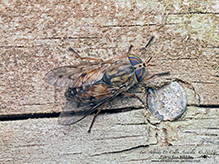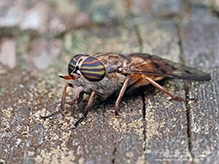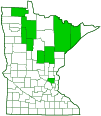orange-sided horse fly
(Hybomitra lasiophthalma)
Conservation • Description • Habitat • Ecology • Distribution • Taxonomy
|
|
||||||||||||||
Description |
Orange-sided horse fly is a common, easily recognized, moderate-sized, horse fly. It occurs in the United States and southern Canada east of the Great Plains, but it is mostly absent from the deep south. Adults are active from mid-April to mid-July in other areas, but all records from Minnesota are from early May to early July. Males feed on plant nectar. Females feed on the blood of mammals. The larvae are found in moist or wet sod, in sphagnum bogs, and in marshes. Adults are stout-bodied and ½″ to ⅝″ (12 to 15 mm) in length. On the female, the head is broad and it is covered with yellow hairs. Details of the head are important features in identifying species in the genus Hybomitra. The compound eyes are dark reddish-purple with 4 bright greenish-blue bands. They are densely covered with long hairs. They do not meet at the top of the head. There are no simple eyes (ocelli), but in their place there is a raised black bump (ocelli tubercle). From a distance, the tubercle could easily be mistaken for ocelli. Between the eyes, there are three shiny, black, hardened areas (calluses): a subcallus above the antennae bases; a basal callus above and adjacent to the subcallus; and a median callus halfway between the ocelli tubercle and the basal callus. The subcallus is completely hairless (bare). The basal callus is hemispherical. The median callus is small. Both the cheeks (gena) and the plate on the face above the upper lip (clypeus) are hairy. The antennae are mostly orange, black just at the tip. The thorax is brownish black with four narrow longitudinal pale stripes. On each side of the thorax, the small elongated triangular plate below the prescutum (notopleuron) is pale or reddish, and it contrasts with adjacent thoracic plates. The abdomen has 7 segments (tergites). It is brownish black with a highly variable amount of orange. Typically, tergites 1 through 4 are mostly orange on the sides and dark in the middle. The wings are faintly tinted. All crossveins are bordered with a conspicuous black spot, and there is a conspicuous black spot on the fork of vein R4+5. On males the compound eyes meet at the top of the head. The eyes have just 3 color bands all on the lower half of the eye. The body is slightly darker due to more abundant black hairs. |
Size |
Total length: ½″ to ⅝″ (12 to 15 mm) |
Similar Species |
Habitat |
|
Ecology |
Season |
May to July |
Behavior |
|
Life Cycle |
A small, shiny, black mass of eggs is laid on a plant leaf. It looks like a tar spot. |
Larva Food |
|
Adult Food |
Males feed on plant nectar. Females feed on the blood on mammals. |
Distribution |
||
|
Sources |
|
| 2/19/2025 | ||
Occurrence |
||
Common |
||
Taxonomy |
|
Order |
|
Suborder |
Brachycera |
Infraorder |
Orthorrhapha |
Parvorder |
Tabanomorpha (snipe flies and allies) |
Superfamily |
Tabanoidea |
Family |
Tabanidae (horse and deer flies) |
Subfamily |
Tabaninae (horse flies) |
Tribe |
Tabanini |
Genus |
Hybomitra |
Subordinate Taxa |
|
|
|
Synonyms |
|
Tabanus fretus Tabanus guttiferus Tabanus lasiophthalmus Tabanus notabilis Tabanus punctipennis Tabanus redactus |
|
Common Names |
|
orange-sided horse fly |
|
Glossary
Clypeus
On insects, a hardened plate on the face above the upper lip (labrum).
Gena
In insects: The area between the compound eye and the mandible; the cheek. In birds: The area between the the angle of the jaw and the bill; the feathered side (outside) of the under mandible. Plural: genae.
Ocellus
Simple eye; an eye with a single lens. Plural: ocelli.
Tergite
The upper (dorsal), hardened plate on a segment of the thorax or abdomen of an arthropod or myriapod.
Visitor Photos |
||
Share your photo of this insect. |
||
This button not working for you? |
||
Alfredo Colon |
||
 |
 |
|
MinnesotaSeasons.com Photos |
||
|
||
|
||

Slideshows |
|

Visitor Videos |
||
Share your video of this insect. |
||
This button not working for you? |
||
|
Other Videos |
||
|

|
Created: 2/19/2025 Last Updated: © MinnesotaSeasons.com. All rights reserved. |


